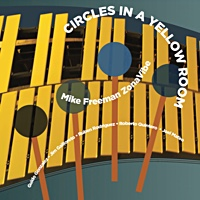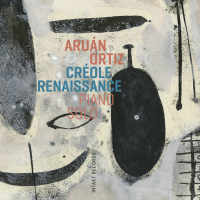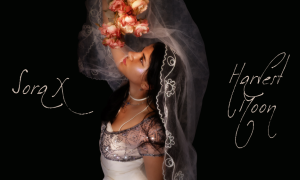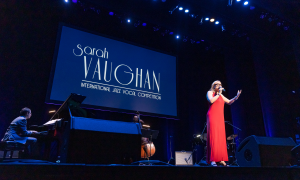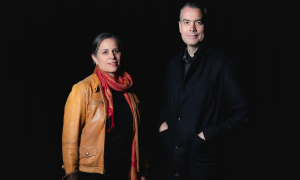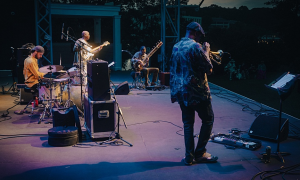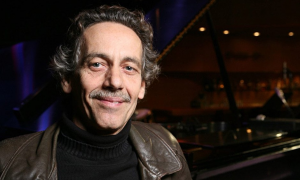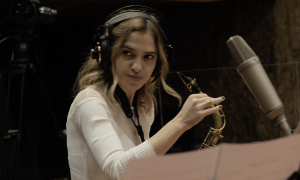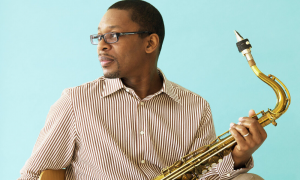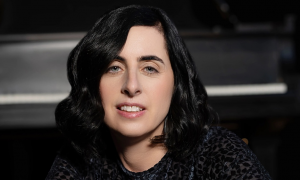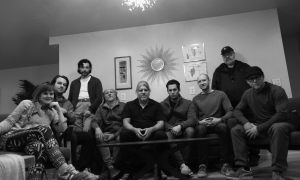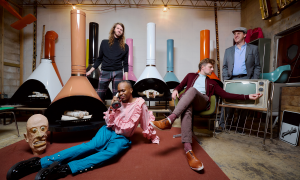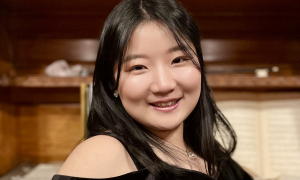Taken at Famed Lindsay's Sky Bar in Cleveland
OBERLIN, OHIO -- Frank Kuchirchuk, a retired photographer who took live performance photographs of some of the greatest jazz artists during the height of their careers, has donated his entire collection of jazz images to the Oberlin Conservatory of Music. The Frank Kuchirchuk Collection of Jazz Photography contains some 200 images, most of which are negatives that have never been seen by the public. The collection will be cataloged and archived within Oberlin's Phyllis Litoff Building, which is currently under construction and scheduled to open later this year. A selection of the photographs will be displayed within the building, which will house Oberlin's Jazz Studies Department and its academic programs in music history and music theory.
| Photograph of Billie Holliday by Frank Kuchirchuk © 2009 Oberlin Conservatory of Music Oberlin, Ohio |
Kuchirchuk's process was inventive, if not cumbersome and painstaking. Because he wanted to achieve “a theatricality, something extremely dramatic" in his performance shots, he says that he “began playing around" with different lighting techniques and effects. “I would sit at home with the lights down and listen to jazz records. The warmth that I felt in those performances when I was sitting in my darkened room was what I wanted to accomplish with my photographs," he says.
To do this he used flash lighting in multiple locations in addition to the flash on the camera itself—he set one light up behind the stage for backlighting, and one or two off to either side of the stage. “I could unplug the light on the camera to achieve different effects," he says. The flash bulbs that he used had to be replaced after each exposure. To avoid disrupting the performance, he had to wait until a set concluded so that he could change out the flash bulbs and take another photo.
 Photo of Dizzy Gillespie by Frank Kuchirchuk © 2009 Oberlin Conservatory of Music Oberlin, Ohio |
Kuchirchuk's only national recognition was fleeting: the 1953 Metronome Yearbook featured his work in a 16-page spread, naming him Photographer of the Year. The Sky Bar closed in 1954, and Kuchirchuk never took another jazz photograph. The large-as-life images he had captured on film were put aside while he concentrated on photo assignments for INS and, later, United Press International. (One of those assignments included coverage of the notorious Sam Sheppard murder case and trial in 1954.)
“I realized that I had a valuable asset in these photos but didn't know what to do with them until I read about Oberlin," says Kuchirchuk. A November 2007 Plain Dealer article about several million dollars in gifts donated to Oberlin for the Phyllis Litoff Building, inspired him to entrust his collection to Oberlin: “I thought, 'Hey—everybody knows about Oberlin!'" Kuchirchuk sensed that Oberlin's reputation as one of the country's top conservatories, as well as its national profile, would secure for the collection the protection and the attention that it deserves.
“As a sometime photographer myself, I was very excited when Frank first contacted me about his collection," says Associate Dean of the Conservatory Michael Lynn, who is also professor of recorder and baroque flute and curator of musical instruments. “I have now gotten to know each image thoroughly during the process of scanning the negatives and doing some minor restoration. Every photograph Frank took speaks with its own voice, bringing life to the musicians. You can almost hear the music just by looking at them."
“I think this is a tremendous gift," says Professor of African American Music Wendell Logan, Chair of Oberlin's Jazz Studies Department. “Typically there are a few popular photos that reappear in different contexts that we're all familiar with. His catalog consists of photos that have never been seen before. For students to see images of the people who actually created the music that they're learning to play—in various performance contexts—is a very beneficial thing. These names jump from the page when you can associate a picture with them. We are certainly indebted to him for thinking of us."
This spring Oberlin is planning a special exhibition of selected images from the Kuchirchuk Collection at a date and venue to be announced. When the Phyllis Litoff Building opens later this year, the photographs will find their permanent home.
About the Oberlin Conservatory of Music
The Oberlin Conservatory of Music, founded in 1865 and situated amid the intellectual vitality of Oberlin College since 1867, is the oldest continuously operating conservatory in the United States. Renowned internationally as a professional music school of the highest caliber and pronounced a “national treasure" by the Washington Post, its alumni have gone on to achieve illustrious careers in all aspects of the serious music world. In reviewing the American premiere of Olga Neuwirth's opera Lost Highway for the New York Times, Vivien Schweitzer noted that “Oberlin has produced some of the top names in contemporary music... Oberlin's rural experimental haven has resulted in successful music careers in a cutthroat marketplace." Oberlin offers a premier undergraduate jazz studies program, chaired by Professor of African American Music Wendell Logan, that prepares students for careers as professional jazz musicians and for advanced study in jazz. The jazz studies faculty includes composers and performers who, in addition to teaching lessons and coaching ensembles, maintain active performing careers throughout the world. Numerous Oberlin alumni have achieved success in the jazz idiom, among them keyboardist Ted Baker, pianist and composer Stanley Cowell, bassist, composer, and arranger Leon Lee Dorsey, pianist, arranger, and producer Allen Farnham, bassist Ben Jaffe, composer and pianist Jon Jang, writer, composer, and saxophonist James McBride, and trumpeter, trombonist, and composer Michael Mossman.
For more information contact All About Jazz.











